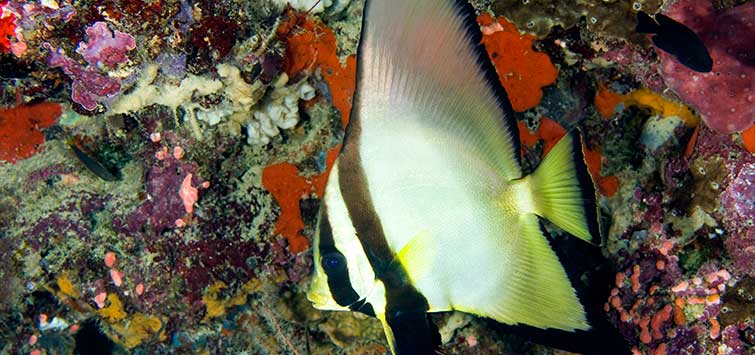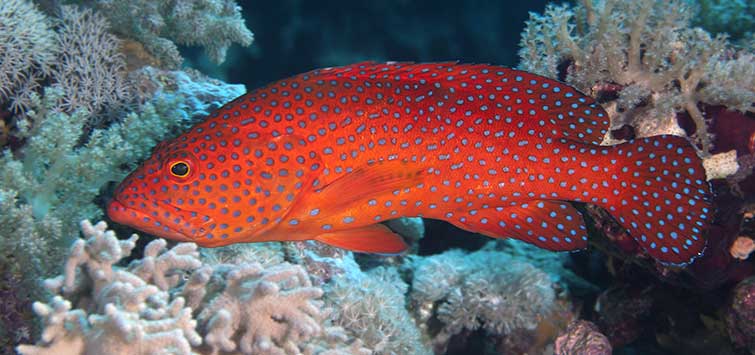The Salt Creep: They're So Cute… When They're Small
Author: Jeff Kurtz
Back in the late ‘90s, I spent several weeks each year helping a friend with his fledgling live-rock project down in the Florida Keys. I was there primarily to assist with heavy lifting and to help dig out rocks that were buried in the sand on the ocean floor after a tropical storm or hurricane pummeled the site. But also on each trip, my friend would reward my efforts by financing as many recreational dives as our tight schedule would allow.
Diving into the Story
As a lifelong Ohioan with a passion for marine fish and invertebrates, these dives were among the most memorable experiences of my life. Drifting weightless among the coral heads, dazzled by the stunning diversity of corals and fishes passing in and out of view, I was afraid to focus my attention on one thing for too long lest I miss something even more memorable.
But on one particular dive, a tiny silver-and-black fish, no larger than my index finger, with long, flowing dorsal and caudal fins, somehow managed to catch my eye and distract me from the endless parade of show-stopping species. The specimen was hovering just above the sand at the base of the reef, its fins waving gently in the current. I fully expected it to dash for cover as I approached for a closer look, but to my surprise it never made a move to evade me.
I was smitten. Though not the most colorful critter on the reef, this diminutive fish was as cute as they come and utterly unimpressed by my physical stature—relative to it, anyway—and the noisy bubbles I was blowing with each exhalation. Naturally, I wondered how this endearing fish would fare in my aquarium. But what type of fish was I looking at?
Which Fish Is It?
Probably a juvenile jackknife fish Equetus lanceolatus, my friend proposed after the dive. A juvenile high-hat Pareques acuminatus, suggested another diver. Unfortunately, I didn’t have the opportunity to capture the fish on film, so I had to rely on my flawed memory to help pick out the fish from an ID book back at the dive shop. However, based on photos in the book, both suggestions seemed plausible.
Crisis Avoided
But after doing a little further research, I learned that it didn’t really matter which of the two species I’d actually seen, since neither would have been appropriate for my aquarium circumstances at the time. Both the jackknife fish and the high-hat approach 10 inches in adult length, which would have exceeded the capacity of the already-well-stocked 55-gallon aquarium I was keeping at the time. Besides, neither species adapts particularly well to eating standard aquarium fare. Had I made the decision to keep one of these fish based solely on the cuteness factor, I would have made a mistake.
Fish That Can Get Too Big Too Fast
Unfortunately, cuteness is all too often the overriding impetus when we pick out fish for our marine aquariums. And all too often, those cute little fish grow into big, boisterous tankbusters that soon overburden the typical home aquarium. Or those adorable little fish may frustrate every feeding effort and gradually starve to death. What follows is just a small sampling of marine fish that are often available in the aquarium trade as cute juveniles, but may end up giving hobbyists more than they bargained for.
Panther Grouper
White overall and speckled with bold black polka dots, the panther grouper Cromileptes altivelis is truly an eye-catching species. It’s also packed with piscine personality for those hobbyists who admire both good looks and interesting behavior. Given these attributes, when you first lay eyes on a cute, comical 4-inch specimen for sale at your local fish store, the impulse to buy can prove almost irresistible. But don’t let that cuteness fool you.
The problem with the panther grouper is not that it won’t acclimate to aquarium conditions. It’s actually quite well-suited to aquarium life and will readily learn to accept meaty food offerings. The trouble is, C. altivelis is a hefty eater, grows rapidly, and will eventually reach a length in excess of 2 feet. That’s fine if you’ve got a really large tank—at least 200 gallons—and no fish or motile invertebrates small enough for the grouper to swallow. But the average small- to medium-size home aquarium simply won’t do to house this species as an adult.
Red-rimmed Batfish
As a juvenile, the red-rimmed batfish Platax pinnatus is absolutely adorable. Dark brown to black in overall coloration, with a brilliant red margin around its vertically elongated body, a juvenile P. pinnatus can turn the head of even the most jaded hobbyist. Its stunning good looks invite the inexperienced or uninformed fishkeeper—who simply must possess this exotic species—to open his or her pocketbook. However, trouble lies ahead when an aquarist buys this species based on its juvenile charms.
The problem with P. pinnatus is exactly the opposite of that presented by C. altivelis. Though it can grow to be fairly large (approximately 18 inches) in nature, the challenge with this species is that it seldom adapts to captive feeding and typically starves to death in the aquarium. To make matters worse, even if you are able to keep this species alive until adulthood, you’ll be disappointed to discover that its beautiful black-and-red coloration will fade to dull silver, and its graceful flowing fins will become significantly shorter.
Given its dismal captive survival record, I’m always amazed that some dealers continue to sell this species. But then, as long as there are uninformed buyers (and dealers) out there who make it profitable to sell doomed fish species, this practice is likely to continue.
Harlequin Sweetlips
With the harlequin sweetlips Plectorhinchus chaetodonoides you get the worst of both worlds. Absurdly cute as a juvenile—and somewhat reminiscent of a clownfish with its orange-brown base color, white blotches, and clumsy mode of swimming—the young harlequin sweetlips is a notoriously finicky eater prone to starving in captivity.
As an adult its coloration shifts to white with numerous small black spots and it reaches an impressive length of over 28 inches. With these two strikes against it—fussy eating habits and prohibitive adult size—P. chaetodonoides is best left on the reef or in the care of expert professional aquarists who have the space and wherewithal to meet its specialized needs.
Dragon Wrasse
This species undergoes one of the more dramatic morphological changes from the juvenile stage to adulthood. In fact, the juvenile and adult stages of this species are so different that they were once thought to be separate species. As a youngster, the dragon wrasse Novaculichthys taeniourus has an olive-green base coloration disrupted by patches of white and brown vertical bands. Arching, elongated appendages extend comically from its head and give rise to another common name for this species, the reindeer wrasse.
But as with the red-rimmed batfish, the irresistible cuteness of N. taeniourus gradually gives way to less impressive coloration and morphology (though some would argue that the adults are attractive in their own right). Adults are brown overall with white, oval-shaped markings on each scale, and their dull gray heads lack the endearing appendages found on the juvenile. At maturity, they approach a foot in length and are considerably more belligerent than juveniles. They also have the proclivity to flip over rocks in search of prey, which gives rise to yet another common name for this species, the rockmover wrasse. Couple that with the fish’s tendency to bury itself in the sand (in common with many wrasse species), and you’re looking at some serious aquascaping challenges.
Still, the dragon wrasse does adapt well to aquarium life and will readily accept a wide range of fresh, frozen, and freeze-dried foods. Just be aware that this species won’t remain cute for long and must ultimately be housed with similarly large and aggressive species in a fairly sizeable aquarium.
Striped Eel Catfish
One of the more charming and amusing images from coral reef documentaries is that of a school of juvenile striped eel catfish Plotosus lineatus tumbling along the ocean floor in a tight, protective ball. In the juvenile stage, P. lineatus—the only catfish species found on coral reefs—is dark brown with numerous horizontal, creamy-white stripes running the length of its body. While it may be tempting to try to create your own captivating school of these cute little cats in the aquarium, to do so would be a recipe for disaster.
Not only does P. lineatus top out at over a foot in length with an appetite to match, but it also becomes rather drab in coloration and loses that fascinating schooling behavior as an adult. Oh, and did I mention this species is armed with venomous dorsal and pectoral spines? Just imagine the impact on the aesthetics of your aquarium—not to mention your biological filter—that would be created by a group of foot-long, visually unappealing, venomous catfish continually grubbing through the substrate in search of food. Not exactly a cute picture!
The List Goes On and On
Of course, many other marine fish species could be included in this list of cute-juveniles-turned-tankbusters. I didn’t even touch upon the sharks—you know, those cute little bamboo sharks sold either still wriggling inside their egg casings or as irresistible juveniles. But I think the message should be clear that, as responsible hobbyists, we must arm ourselves with knowledge so we can be prepared to successfully manage the species in our care throughout the course of their lives.
We can’t assume that we’ll simply return a specimen to our local aquarium dealer once it gets too big and boisterous to handle. And the same holds true for public aquariums. They receive calls virtually every day from hobbyists trying to find a new home for fish that have outgrown their tanks, and they just don’t have the space or manpower to take them all in. As conscientious aquarists, when we make the commitment to house any specimen, we should have its long-term needs foremost in mind.

.png?h=595&iar=0&w=2781&hash=5FD5E69473BCC22199FBFA2FB71B6033)



